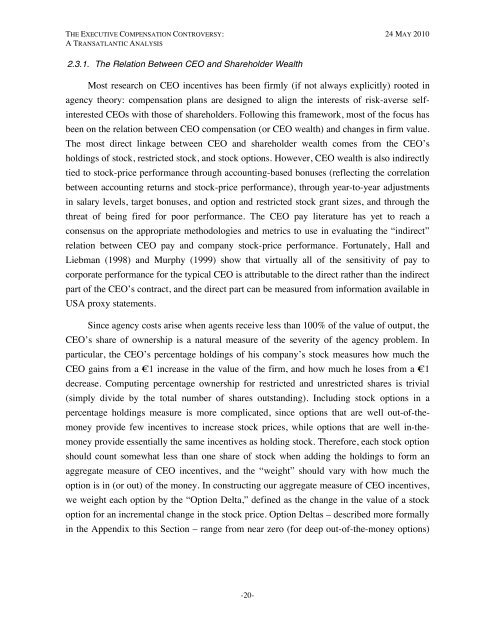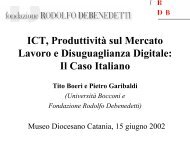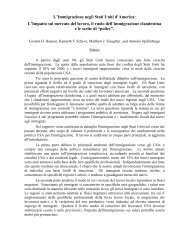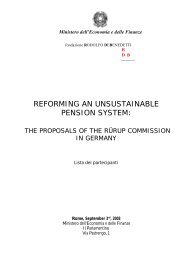The Executive Compensation Controversy - Fondazione Rodolfo ...
The Executive Compensation Controversy - Fondazione Rodolfo ...
The Executive Compensation Controversy - Fondazione Rodolfo ...
You also want an ePaper? Increase the reach of your titles
YUMPU automatically turns print PDFs into web optimized ePapers that Google loves.
THE EXECUTIVE COMPENSATION CONTROVERSY: 24 MAY 2010A TRANSATLANTIC ANALYSIS2.3.1. <strong>The</strong> Relation Between CEO and Shareholder WealthMost research on CEO incentives has been firmly (if not always explicitly) rooted inagency theory: compensation plans are designed to align the interests of risk-averse selfinterestedCEOs with those of shareholders. Following this framework, most of the focus hasbeen on the relation between CEO compensation (or CEO wealth) and changes in firm value.<strong>The</strong> most direct linkage between CEO and shareholder wealth comes from the CEO’sholdings of stock, restricted stock, and stock options. However, CEO wealth is also indirectlytied to stock-price performance through accounting-based bonuses (reflecting the correlationbetween accounting returns and stock-price performance), through year-to-year adjustmentsin salary levels, target bonuses, and option and restricted stock grant sizes, and through thethreat of being fired for poor performance. <strong>The</strong> CEO pay literature has yet to reach aconsensus on the appropriate methodologies and metrics to use in evaluating the “indirect”relation between CEO pay and company stock-price performance. Fortunately, Hall andLiebman (1998) and Murphy (1999) show that virtually all of the sensitivity of pay tocorporate performance for the typical CEO is attributable to the direct rather than the indirectpart of the CEO’s contract, and the direct part can be measured from information available inUSA proxy statements.Since agency costs arise when agents receive less than 100% of the value of output, theCEO’s share of ownership is a natural measure of the severity of the agency problem. Inparticular, the CEO’s percentage holdings of his company’s stock measures how much theCEO gains from a €1 increase in the value of the firm, and how much he loses from a €1decrease. Computing percentage ownership for restricted and unrestricted shares is trivial(simply divide by the total number of shares outstanding). Including stock options in apercentage holdings measure is more complicated, since options that are well out-of-themoneyprovide few incentives to increase stock prices, while options that are well in-themoneyprovide essentially the same incentives as holding stock. <strong>The</strong>refore, each stock optionshould count somewhat less than one share of stock when adding the holdings to form anaggregate measure of CEO incentives, and the “weight” should vary with how much theoption is in (or out) of the money. In constructing our aggregate measure of CEO incentives,we weight each option by the “Option Delta,” defined as the change in the value of a stockoption for an incremental change in the stock price. Option Deltas – described more formallyin the Appendix to this Section – range from near zero (for deep out-of-the-money options)-20-









